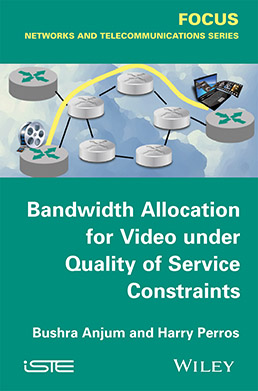
The famous trichotomous Quality of Service (QoS) triangle consists of three main players: the sender, the receiver and the Internet Service Provider (ISP), also known as the carrier. The sender wants to send any type of traffic any time, whereas the receiver expects to receive all this sent traffic intact, with low delay. In addition, the third player, the carrier, wants to use the minimum possible network capacity per customer, so that it can take more customers on its network, resulting in higher profits. Between the three components, with high stakes in the designing and provisioning of the IP-based Internet, the overall performance of a network is established. However, it is the competing expectations and demands of the three parties that makes QoS design and provisioning such an interesting topic and ongoing research problem.
This book describes queuing-based solutions for estimating the bandwidth required for a video stream of packets so that a given percentile of the end-to-end delay is satisfied. In addition, a thorough investigation of the bandwidth required to satisfy given constraints on the percentile end-to-end delay, jitter, and packet loss rate, is undertaken using a CPU-efficient activity-based simulation model.
Within this theme, this book provides analytic expressions for adding percentiles, queuing-analytic calculation of the percentile end-to-end delay assuming an MMPP2 (two-stage Markov-Modulated Poisson Process) or MAP2 (two-stage Markov Arrival Process) arrival process. The authors also provide qualitative results on the dominance of constraints on the percentile end-to-end delay, jitter, and packet loss rate, as well as examples using traces from Telepresence, WebEx, and IPTV.
1. Partitioning the End-to-End QoS Budget to Domains.
2. Bandwidth Allocation for Video: MMPP2 Arrivals.
3. Bandwidth Allocation for Video: MAP2 Arrivals.
4. Bandwidth Allocation for Video: Video Traces.
Bushra Anjum is a Fulbright scholar and Assistant Professor in the Computer Science department at Missouri University of Science and Technology in the USA. Her research interests include mathematical and simulation based foundations of performance evaluation, network modeling and resource allocation under QoS constraints, queuing theory, data & network analytics and data science.
Harry Perros is an IEEE Fellow, Professor of Computer Science and the co-founder and program coordinator of the Master of Science degree in Computer Networks at NC State University in the USA. His current research interests are in the areas of video traffic modeling, resource allocation under QoS, capacity planning of clouds, IoT, queuing theory and hidden Markov models.